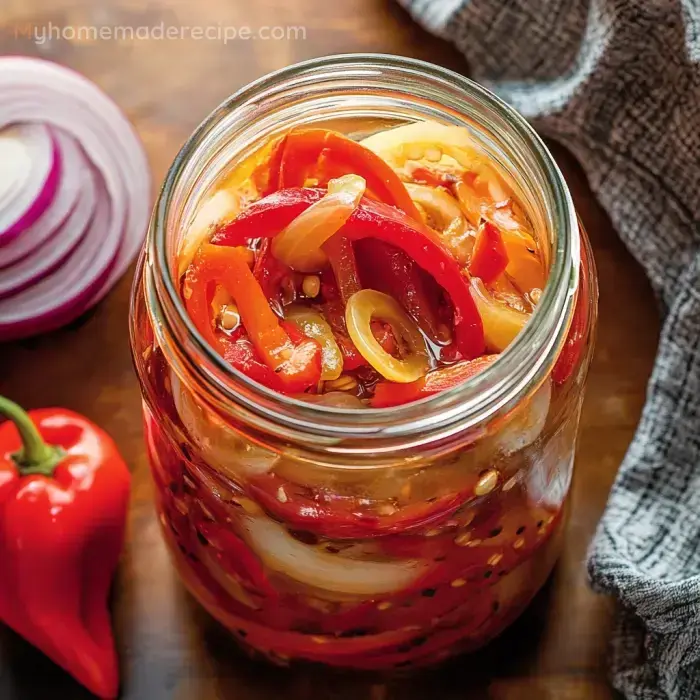Quick pickling is a method of preserving vegetables and fruits that has gained immense popularity due to its ease, speed, and the vibrant flavors it produces. One of the most versatile and delicious outcomes of quick pickling is the creation of pickled sweet peppers and onions. These tangy, crunchy, and flavorful pickles are a staple in many kitchens, adding a burst of flavor to a variety of dishes. In this article, we will delve into the world of quick pickled sweet peppers and onions, exploring their advantages, the ingredients and tools needed, the step-by-step process of making them, and various ways to enjoy them.
Personally, I have always been a fan of pickled sweet peppers and onions. They were a common condiment in my household growing up, and their presence could elevate even the simplest of meals. Whether it was a sandwich, a burger, or a salad, the addition of these pickles always brought a smile to my face. Over the years, I have perfected my own recipe, and I am excited to share it with you.
What is Quick Pickling?
Quick pickling is a simplified method of pickling that does not require the traditional canning process. Unlike canning, which involves sterilizing jars and sealing them to create a vacuum, quick pickling is a straightforward process that involves marinating vegetables or fruits in a brine. This method is perfect for those who want to enjoy the benefits of pickling without the hassle of canning.
The quick pickling method preserves vegetables and fruits by submerging them in a brine made from vinegar, water, sugar, salt, and various spices. The acidity in the vinegar acts as a natural preservative, allowing the pickles to be stored in the refrigerator for several weeks or even months. This method is not only easy but also fast, with most pickles ready to eat within a few hours or overnight.
The benefits of quick pickling are numerous. It is a great way to use up a surplus of vegetables, especially during peak seasons. The process is relatively quick, and the ingredients are simple and readily available. Moreover, quick pickling allows for a high degree of customization, enabling you to adjust the flavors according to your preferences.
Ingredients and Tools
- Sweet Red Peppers
- Vidalia Onion
- White Vinegar
- Garlic Cloves
- Granulated Sugar
- Kosher Salt
- Red Pepper Flakes
- Bay Leaf
- Mustard Seeds
- Cutting Board and Chef's Knife
- Measuring Cups and Spoons
- Mason Jars
Instructions
- Preparation
- The first step in making quick pickled sweet peppers and onions is to prepare the vegetables. Wash the peppers and onions thoroughly, then slice them very thinly. You can use a mandoline or a sharp chef's knife to get even, thin slices. Uniform sizes are important to ensure that the vegetables pickle evenly. Layer the sliced peppers and onions in clean mason jars. Make sure to pack them tightly but not too tightly, as they will expand slightly during the pickling process. You can also add a few garlic cloves to each jar for extra flavor.
- Making the Brine
- To make the brine, combine the vinegar, water, sugar, salt, garlic, mustard seeds, bay leaf, and red pepper flakes (if using) in a small saucepan. Bring the mixture to a boil over medium heat, stirring occasionally until the sugar and salt are dissolved. This process should take about 10 minutes, depending on the heat and the ingredients used. Once the brine has come to a boil and the sugar and salt are dissolved, remove it from the heat. Let it cool slightly before pouring it over the peppers and onions in the mason jars. Make sure the vegetables are fully submerged in the brine. If necessary, add a bit more water or vinegar to cover them completely.
- Assembling the Pickles
- Pour the hot brine over the peppers and onions in the mason jars. Use a butter knife or a non-metallic utensil to press down the vegetables and remove any air bubbles. This ensures that all the vegetables are fully coated with the brine and helps prevent spoilage. Let the mixture cool to room temperature before screwing on the lids and storing the jars in the refrigerator. The pickles will be ready to eat within a few hours or overnight, depending on your preference. The longer they sit, the tangier they will become.
Serving Suggestions
Pickled sweet peppers and onions are incredibly versatile and can be used in a variety of dishes. Here are some popular ways to enjoy them:
Condiments for Sandwiches, Hot Dogs, Burgers, or Tacos
These pickles make an excellent condiment for sandwiches, hot dogs, burgers, or tacos. They add a tangy, crunchy texture and a burst of flavor that complements meats and cheeses perfectly. Whether you are making a simple sandwich or a gourmet burger, pickled sweet peppers and onions are a great addition.
Toppings for Salads, Chili, Soup, or Pizza
Pickled sweet peppers and onions are also great as toppings for salads, chili, soup, or pizza. They add a tangy flavor and a crunchy texture that enhances the overall taste of the dish. For salads, they pair well with mixed greens, nuts, and a variety of cheeses. On pizza, they add a sweet and sour flavor that complements the savory flavors of the cheese and sauce.
Side for Grilled Veggies, Fish, and Meats
Pickled sweet peppers and onions make a great side dish for grilled vegetables, fish, and meats. They add a cool, tangy flavor that balances out the smoky flavors of grilled foods. Whether you are grilling vegetables, fish, or meats, these pickles are a perfect accompaniment.
Addition to Charcuterie Board, Cheese Plate, or with Hummus and Chips
These pickles are also a great addition to a charcuterie board, cheese plate, or served with hummus and chips. They add a tangy, crunchy element that complements cheeses, meats, and dips. For a quick and easy snack, serve the pickles with hummus and pita chips or crackers.
Tips and Considerations
- Non-Reactive Pans
- Fresh Produce
- Uniform Sizes
- Boiling Vinegar
Recipe Details
- Course: Extras or Side Dishes
- Cuisine: American
- Prep Time: 20 minutes
- Cook Time: 10 minutes
- Total Time: 30 minutes
- Servings: 12
- Calories: 60 kcal
Conclusion
Making quick pickled sweet peppers and onions is a simple and rewarding process that adds a burst of flavor to any meal. The ease and speed of this method make it perfect for busy cooks who want to enjoy the benefits of pickling without the hassle of traditional canning. With their tangy, crunchy texture and versatile uses, pickled sweet peppers and onions are a must-have in any kitchen. Whether you are looking for a flavorful condiment for sandwiches, a topping for salads, or a side dish for grilled foods, pickled sweet peppers and onions are the perfect choice. They are easy to make, delicious to eat, and can be customized to suit your taste preferences. So, go ahead and give this recipe a try, and explore the various ways you can enjoy these quick pickled sweet peppers and onions.
 Pin it
Pin it
